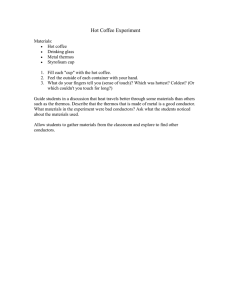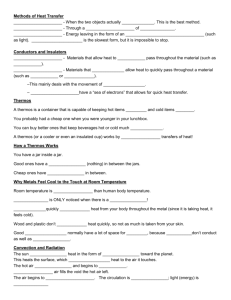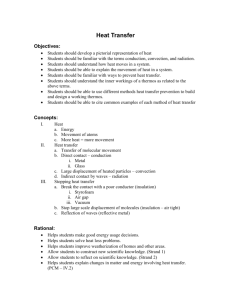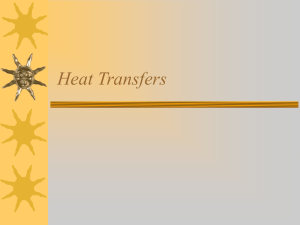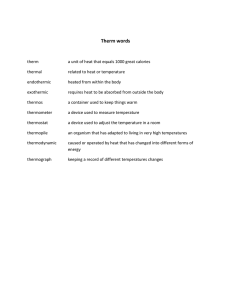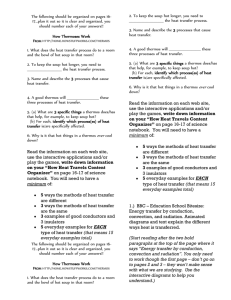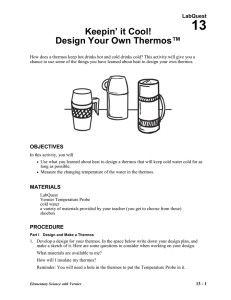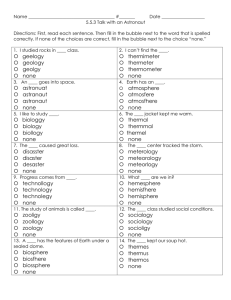Modeling heat flow in a thermos - Michael A. Karls Home Page
advertisement
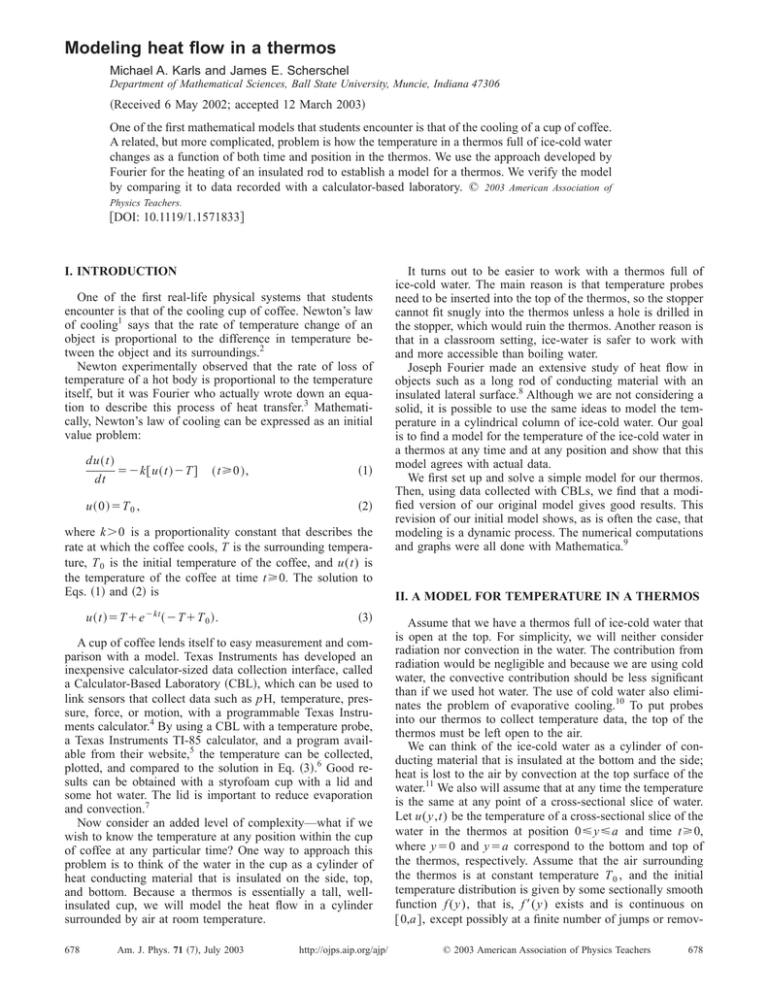
Modeling heat flow in a thermos Michael A. Karls and James E. Scherschel Department of Mathematical Sciences, Ball State University, Muncie, Indiana 47306 共Received 6 May 2002; accepted 12 March 2003兲 One of the first mathematical models that students encounter is that of the cooling of a cup of coffee. A related, but more complicated, problem is how the temperature in a thermos full of ice-cold water changes as a function of both time and position in the thermos. We use the approach developed by Fourier for the heating of an insulated rod to establish a model for a thermos. We verify the model by comparing it to data recorded with a calculator-based laboratory. © 2003 American Association of Physics Teachers. 关DOI: 10.1119/1.1571833兴 I. INTRODUCTION One of the first real-life physical systems that students encounter is that of the cooling cup of coffee. Newton’s law of cooling1 says that the rate of temperature change of an object is proportional to the difference in temperature between the object and its surroundings.2 Newton experimentally observed that the rate of loss of temperature of a hot body is proportional to the temperature itself, but it was Fourier who actually wrote down an equation to describe this process of heat transfer.3 Mathematically, Newton’s law of cooling can be expressed as an initial value problem: du 共 t 兲 ⫽⫺k 关 u 共 t 兲 ⫺T 兴 dt 共 t⭓0 兲 , u 共 0 兲 ⫽T 0 , 共1兲 共2兲 where k⬎0 is a proportionality constant that describes the rate at which the coffee cools, T is the surrounding temperature, T 0 is the initial temperature of the coffee, and u(t) is the temperature of the coffee at time t⭓0. The solution to Eqs. 共1兲 and 共2兲 is u 共 t 兲 ⫽T⫹e ⫺kt 共 ⫺T⫹T 0 兲 . 共3兲 A cup of coffee lends itself to easy measurement and comparison with a model. Texas Instruments has developed an inexpensive calculator-sized data collection interface, called a Calculator-Based Laboratory 共CBL兲, which can be used to link sensors that collect data such as pH, temperature, pressure, force, or motion, with a programmable Texas Instruments calculator.4 By using a CBL with a temperature probe, a Texas Instruments TI-85 calculator, and a program available from their website,5 the temperature can be collected, plotted, and compared to the solution in Eq. 共3兲.6 Good results can be obtained with a styrofoam cup with a lid and some hot water. The lid is important to reduce evaporation and convection.7 Now consider an added level of complexity—what if we wish to know the temperature at any position within the cup of coffee at any particular time? One way to approach this problem is to think of the water in the cup as a cylinder of heat conducting material that is insulated on the side, top, and bottom. Because a thermos is essentially a tall, wellinsulated cup, we will model the heat flow in a cylinder surrounded by air at room temperature. 678 Am. J. Phys. 71 共7兲, July 2003 http://ojps.aip.org/ajp/ It turns out to be easier to work with a thermos full of ice-cold water. The main reason is that temperature probes need to be inserted into the top of the thermos, so the stopper cannot fit snugly into the thermos unless a hole is drilled in the stopper, which would ruin the thermos. Another reason is that in a classroom setting, ice-water is safer to work with and more accessible than boiling water. Joseph Fourier made an extensive study of heat flow in objects such as a long rod of conducting material with an insulated lateral surface.8 Although we are not considering a solid, it is possible to use the same ideas to model the temperature in a cylindrical column of ice-cold water. Our goal is to find a model for the temperature of the ice-cold water in a thermos at any time and at any position and show that this model agrees with actual data. We first set up and solve a simple model for our thermos. Then, using data collected with CBLs, we find that a modified version of our original model gives good results. This revision of our initial model shows, as is often the case, that modeling is a dynamic process. The numerical computations and graphs were all done with Mathematica.9 II. A MODEL FOR TEMPERATURE IN A THERMOS Assume that we have a thermos full of ice-cold water that is open at the top. For simplicity, we will neither consider radiation nor convection in the water. The contribution from radiation would be negligible and because we are using cold water, the convective contribution should be less significant than if we used hot water. The use of cold water also eliminates the problem of evaporative cooling.10 To put probes into our thermos to collect temperature data, the top of the thermos must be left open to the air. We can think of the ice-cold water as a cylinder of conducting material that is insulated at the bottom and the side; heat is lost to the air by convection at the top surface of the water.11 We also will assume that at any time the temperature is the same at any point of a cross-sectional slice of water. Let u(y,t) be the temperature of a cross-sectional slice of the water in the thermos at position 0⭐y⭐a and time t⭓0, where y⫽0 and y⫽a correspond to the bottom and top of the thermos, respectively. Assume that the air surrounding the thermos is at constant temperature T 0 , and the initial temperature distribution is given by some sectionally smooth function f (y), that is, f ⬘ (y) exists and is continuous on 关 0,a 兴 , except possibly at a finite number of jumps or remov© 2003 American Association of Physics Teachers 678 able discontinuities. This simple system can be modeled by the following initial value-boundary value problem for t⬎0 and 0⬍y⬍a: 2u c u ⫺ ⫽0, y2 t 共4兲 u 共 0,t 兲 ⫽0, y 共5兲 u 共 a,t 兲 ⫹ u 共 a,t 兲 ⫽T 0 , h y 共6兲 u 共 y,0兲 ⫽ f 共 y 兲 . 共7兲 Equation 共4兲 is known as the one-dimensional heat equation and , c, , and h are the density, specific heat, thermal conductivity, and convection coefficient, respectively. By using Fourier’s law of heat conduction,8 q 共 y,t 兲 ⫽⫺ u 共 y,t 兲 , y 共8兲 where q(y,t) is the heat flow rate, we see that the boundary condition 共5兲 indicates that there is no heat flow through the bottom of the thermos. Similarly, Fourier’s law of heat conduction applied to the boundary condition 共6兲 shows that at the top of the thermos, the heat flow rate is proportional to the difference in temperature between the air and the top of the thermos. Thus, boundary condition 共6兲 can be thought of as a form of Newton’s law of cooling. The known initial temperature distribution in the water is given by Eq. 共7兲. By using the technique of separation of variables, the solution to Eqs. 共4兲–共7兲 is found to be 共see the Appendix for an outline of the solution兲 ⬁ u 共 y,t 兲 ⫽T 0 ⫹ 兺 B n cos共 n y 兲 e ⫺ t/ c , n⫽1 2 n 共9兲 where n is the unique solution to tan共 n a 兲 ⫽ h n 共10兲 in the interval 共 n⫺1 兲 共 2n⫺1 兲 ⬍ n ⬍ . a 2a 共11兲 The coefficients B n are given by B n⫽ 兰 a0 关 f 共 y 兲 ⫺T 0 兴 cos共 n y 兲 dy 兰 a0 关 cos共 n y 兲兴 2 dy . 共12兲 III. VERIFICATION OF THE MODEL Now that we have a model for our thermos, we collect temperature data and test our model experimentally. The following materials are required: four TI-85 graphing calculators 共with temperature collection software兲, four CBLs 共with temperature probes兲, two twist ties, one rubber band, one thermos, ice, water, ruler, and a freezer. The experimental procedure is as follows: 共1兲 Measure the depth of the interior of the thermos. 共2兲 Use the two twistties to connect three of the temperature probe cables together, with the probes arranged so that the distance between each probe is half of the depth of thermos. 共3兲 Place the 679 Am. J. Phys., Vol. 71, No. 7, July 2003 probes in the freezer. 共4兲 Fill the thermos with ice water and allow it to sit for roughly 2 h to prechill. 共5兲 Then remove the ice from the thermos and top-off the thermos with ice-cold water. 共6兲 Insert the three temperature probes that are twisttied together into the thermos and use the rubber band to keep the probes at the proper heights: one at the bottom, one in the middle, and one at the top, just below the surface of the water. Use the fourth temperature probe to record the ambient room temperature. 共7兲 Use the TI-85 calculators and the CBLs to record the temperature data. 共See Ref. 12 for the recorded data for our experiments.兲 Temperature data was collected once every 120 s for 4 h. To compare our model to the experimental data, we need to specify the parameters in the model. The length of the thermos is a⫽0.28 m and the ambient room temperature is about T 0 ⫽21 °C. Appropriate values of the density and specific heat of water are ⫽1000 kg/m3 and c ⫽4186 J/(kg °C), respectively.13 We take the thermal conductivity of water to be ⫽0.602784 J/(m s °C). 14 Based on convection coefficients found in Ref. 15, we guess that the convection coefficient is h⫽83.72 J/(m2 s °C). We also need to specify an initial temperature distribution function f (y). If the thermos were well-shaken, we would expect that the temperature would initially be uniform. Experimentally we find that the temperature readings initially decrease slightly, then rise such that the top of the thermos has a higher initial temperature than the bottom and middle. The slight decrease in the initial temperature may be due to the probes warming up while being taken from the freezer and inserted into the thermos. The top of the thermos being open to the air may explain the higher initial temperature at the top of the thermos. To take this difference into account, we use a piecewise linear function for f (y) constructed from the points (0,T b ), (a/2,T m ), and (a,T a ), where T b , T m , and T a are the measured initial temperatures at the bottom (y⫽0 m), middle (y⫽a/2⫽0.14 m), and top (y⫽a⫽0.28 m), respectively: f 共 y 兲⫽ 再 冉 冉 冊 冉 冊 冊冉 冊 冉 冊 T m ⫺T b y⫹T b a/2 T a ⫺T m a/2 0⭐y⭐ a y⫺ ⫹T m 2 a , 2 a ⬍y⭐a . 2 共13兲 We now use Eqs. 共10兲 and 共11兲 to find the values of n numerically. These values of n and the initial temperature distribution f (y) can then be substituted into Eq. 共12兲 to find the coefficients, B n , for our model. If we graphically compare the nth partial sum of Eq. 共9兲 at y⫽0 to the initial temperature distribution f (y), we find that 30 terms in Eq. 共9兲 should be enough for our model. Unfortunately, as we see in Fig. 1, the model doesn’t match the experimental results very well. One measure of the error is the mean of the sum of the squares for error 共MSSE兲 which is the average of the sum of the squares of the differences between the measured and model data values.16 In this model, we find the MSSE at the top, middle, and bottom of the thermos is 33.7(°C) 2 , 0.534(°C) 2 , and 0.930(°C) 2 , respectively. Maybe the problem with our model is our choice of the constant h, which was chosen fairly arbitrarily. With the choice of h⫽920.92 J/共m2 s °C), found by finding the best fit with integer multiples of our initial guess of h, we obtain the results shown in Fig. 2 after recomputing the values of n M. A. Karls and J. E. Scherschel 679 Fig. 1. Plot of the temperature (°C) versus time 共minutes兲 at the top 共diamonds兲, middle 共squares兲, and bottom 共stars兲 of the thermos. The solid symbols represent model data and the open symbols represent actual data. Fig. 3. Plot of the temperature versus time at the top, middle, and bottom of the thermos with cotton added, ⫽1.80835 J/(m s°C) and h ⫽1004.64 J/(m2 s°C). The same symbols are used as in Fig. 1. and B n . Although the model is significantly closer to the experimental results for the temperature at the top of the thermos, the model is still off by about the same amount for the middle and bottom of the thermos. The MSSE at the top, middle, and bottom of the thermos is 1.11(°C) 2 , 0.468(°C) 2 , and 0.929(°C) 2 , respectively. Perhaps our assumption that convection plays no significant role is incorrect. To reduce the contribution of this pathway for heat flow, we make the following modification to our experimental procedure and pack the thermos with cotton balls to reduce convection currents. The following additional materials are required for the revised experimental procedure: one bag of 100 cotton balls and one pencil. The modified experimental procedure is as follows: 共3兲 Place the probes and pencil in the freezer. 共3a兲 关after step 共3兲 and before step 共4兲兴 Fill the thermos with cotton balls, remove the cotton balls, and place them in the freezer. 共6a兲 关after step 共6兲 and before step 共7兲兴 Take the cotton balls that were used to fill the thermos in step 共3a兲 and add the cotton balls one-byone to the thermos. Use the chilled pencil to poke them below the waterline. We can now retest our model using the modified experimental procedure. The same values of a, , and c are used. The ambient temperature for this data set is slightly higher, so we take T 0 ⫽24 °C. Because the cotton, probe leads, and convection could affect the apparent value of and our choice for h was really just a guess, we choose and h so that the model matches the data as closely as possible graphically. By tripling our initial choice of and taking multiples of an initial guess for h⫽41.86 J/共m2 s °C), we find that ⫽1.80835 J/共m s °C) and h⫽1004.64 J/共m2 s °C) work well. If we construct a new piecewise linear f (y) and compute n and B n for our new model data, we obtain the results shown in Fig. 3 with 30 terms in the sum for u(y,t). Visually, the model seems to be closer to experimental results, but the bottom and middle model values are still off. For this model, the MSSE at the top, middle, and bottom of the thermos turn out to be 0.396(°C) 2 , 0.576(°C) 2 , and 0.487(°C) 2 , respectively. As a final modification of our model, suppose that we had started with a different initial temperature distribution, say f (y)⫽Ae By ⫹C. This form of f (y) is chosen to model the rapid rise in initial temperature near the top of the thermos. To take into account the fact that the the temperature readings initially decrease slightly, then rise, we will use the points (0,T min,b), (a/2,T min,m), and (a,T min,a), where T min,b , T min,m , and T min,a are the minimum temperature readings recorded at these positions. To find the unknown constants A, B, and C, we solve the system of equations: T min,b⫽ f 共 0 兲 ⫽A⫹C, T min,m⫽ f 共 a/2兲 ⫽Ae 共14a兲 ⫹C, 共14b兲 Ba/2 T min,a⫽ f 共 a 兲 ⫽Ae Ba ⫹C, 共14c兲 yielding A⫽T min,b⫹ 2 ⫺T min,aT min,b T min,m T min,a⫺2T min,m⫹T min,b , 2 T min,m⫺T min,a , B⫽ ln a T min,b⫺T min,m C⫽ Fig. 2. Plot of the temperature versus time at the top, middle, and bottom of the thermos with a new choice for convection coefficient h ⫽920.92 J/(m2 s°C). The same symbols are used as in Fig. 1. 680 Am. J. Phys., Vol. 71, No. 7, July 2003 2 T min,aT min,b⫺T min,m T min,a⫺2T min,m⫹T min,b 共15a兲 共15b兲 . 共15c兲 As before, we compute n and B n using the same and h as in the previous model. Figure 4 shows our results. Of the M. A. Karls and J. E. Scherschel 680 u 共 y,0兲 ⫽T s ⫹Ae ĥy/ , Fig. 4. Plot of the temperature versus time at the top, middle, and bottom of the thermos with cotton added and an exponential initial temperature distribution. The same symbols are used as in Fig. 1. models we have tried, this one provides the best visual fit to the experimental data. We find that the MSSE at the top, middle, and bottom of the thermos are 0.142(°C) 2 , 0.0664(°C) 2 , and 0.0449(°C) 2 , respectively. As a final test of our model, we’ll use it to answer the question: How long does the thermos keep things cold? To do so, we look at the average value of the temperature of the water as a function of time, which is given by the integral17 1 a 冕 a 0 共16兲 u 共 y,t 兲 dy. We compute this integral numerically and find that the model predicts that the temperature of the thermos will warm up to 15 °C in about 1.42 days. Experimentally, the thermos warms up to about 16 °C in a day and a half. IV. CONCLUSIONS AND FURTHER QUESTIONS Using Fourier’s model for heat conduction, we have developed a simple model for the temperature of ice-cold water in a thermos at any position and any time. Based on experimental data, we found that a modified version of our original model agrees with our measured data. One question that arises is why does our last choice of the initial temperature distribution work so well? The main heat transfer mechanism in the thermos is some combination of conduction and convection. In practice, when modeling heat transfer due to conduction or convection, it turns out that Newton’s law of cooling can be used to describe the heat flow rate.11 Therefore, if we assume that for small t, the temperature in the thermos doesn’t change with time, a natural choice for the initial heat flow rate at any point in the thermos would be q 共 y,0兲 ⫽ĥ 关 T s ⫺u 共 y,0兲兴 , 共17兲 where T s is the unknown temperature at the surface of the ice-water and ĥ is a proportionality constant. It follows from Fourier’s law of heat conduction, Eq. 共8兲, that ⫺ u 共 y,0兲 ⫽ĥ 共 T s ⫺u 共 y,0兲兲 y 共 0⬍y⬍a 兲 , which has the general solution 681 Am. J. Phys., Vol. 71, No. 7, July 2003 共18兲 共19兲 where A, T s , and ĥ/ are unknown constants. Equation 共19兲 is exactly the form of our final choice of f (y). This experiment can be safely performed by students in a classroom setting for the small cost of four calculators, four CBLs, and a decent thermos 共we chose a Stanley heavy duty thermos兲. Note that the constants h, k, and T 0 may need to be adjusted to match a different experimental environment. In addition to the experiment we have outlined, other questions such as the following could be addressed. How does adjusting the constants h and k affect the discrepancy between the model and the actual data? Instead of choosing h and k by trial and error, are there mathematical methods that could be used to minimize the discrepancy? What happens if a liquid with different chemical composition than water, such as cola or lemonade, is put in the thermos? Can h and k still be chosen to match the model to the measured data? How well does this model work with hot coffee in the thermos instead of ice-cold water? In a model with a hot liquid, are there any other factors that need to be considered, such as heat lost due to evaporation? APPENDIX: SOLUTION OF THE INITIAL VALUEBOUNDARY VALUE PROBLEM To solve Eqs. 共4兲–共7兲, one typically first finds the steadystate solution v (y), where v (y) is the limit of u(y,t) as t →⬁. 共The steady-state solution can be assumed to exist because of the physical nature of the system. Intuitively, we expect that the contents of the thermos would eventually warm to room temperature, and the temperature would become independent of time. This is why v (y) is called the steady-state solution.兲 We let t→⬁ in Eqs. 共4兲–共7兲 and find that the steady-state solution is v ⬙ 共 y 兲 ⫽0, 共A1兲 v ⬘ 共 0 兲 ⫽0, 共A2兲 v共 a 兲 ⫹ v ⬘ 共 a 兲 ⫽T 0 , h 共A3兲 which has the unique solution v (y)⫽T 0 . Because u(y,t)→ v (y) as t→⬁, if we let w(y,t) ⫽u(y,t)⫺ v (y), it follows that w(y,t)→0 as t→⬁. For this reason, we call w(y,t) the transient solution. If we substitute u(y,t)⫽w(y,t)⫹ v (y) into Eqs. 共4兲–共7兲 and let t→⬁, we obtain the transient problem: 2w c w ⫺ ⫽0, y2 t 共A4兲 w 共 0,t 兲 ⫽0, y 共A5兲 w 共 a,t 兲 ⫹ w 共 a,t 兲 ⫽0, h y w 共 y,0兲 ⫽g 共 y 兲 ⬅ f 共 y 兲 ⫺T 0 . 共A6兲 共A7兲 To solve Eqs. 共A4兲–共A7兲, we use separation of variables or Fourier’s method.8 The key is to assume that w(y,t) is a function of y and t separately, that is, w(y,t)⫽ (y)T(t). With this assumption, Eqs. 共A4兲–共A7兲 become 共for t⬎0) M. A. Karls and J. E. Scherschel 681 ⬙共 y 兲 T 共 t 兲 ⫺ c 共 y 兲 T ⬘ 共 t 兲 ⫽0, ⬘ 共 0 兲 T 共 t 兲 ⫽0, 共A8兲 共A9兲 共 a 兲 T 共 t 兲 ⫹ ⬘ 共 a 兲 T 共 t 兲 ⫽0, h 共A10兲 共 y 兲 T 共 0 兲 ⫽g 共 y 兲 . 共A11兲 If we rearrange Eq. 共A8兲, we see that for all 0⬍y⬍a and all t⬎0, ⬙共 y 兲 c T ⬘共 t 兲 ⫽ . 共 y 兲 T共 t 兲 共A12兲 For Eq. 共A12兲 to hold, each side must be constant. From Eqs. 共A9兲 and 共A10兲, we obtain the boundary conditions in terms of the product of T(t) and (y). Equation 共A9兲 implies that either T(t)⫽0 for all t or ⬘共0兲⫽0. Because we want our transient solution to be continuous up to the boundary, we choose ⬘ 共 0 兲 ⫽0. 共A13兲 Similarly, Eq. 共A10兲 implies that either T(t)⫽0 for all t or 共 a 兲 ⫹ ⬘ 共 a 兲 ⫽0. h 共A14兲 To avoid the trivial solution for w(y,t), we require Eq. 共A14兲. If we set Eq. 共A12兲 equal to a constant A 0 , we find that (y) and T(t) satisfy ⬙ 共 y 兲 ⫺A 0 共 y 兲 ⫽0, T ⬘ 共 t 兲 ⫺A 0 T 共 t 兲 ⫽0. c 共A15兲 共A16兲 The solutions to Eq. 共A16兲 will be of the form T共 t 兲⫽ e A0 共/c兲 t, 共A17兲 where is a real constant. The solution to Eq. 共A15兲 depends on the choice of the constant A 0 and the boundary conditions 共A13兲 and 共A14兲. To have nontrivial transient solutions that decay to zero as t→⬁, A 0 must be negative. For convenience, we write A 0 ⫽⫺ 2 . Then Eq. 共A15兲 has solutions of the form 共 y 兲 ⫽c 1 cos共 y 兲 ⫹c 2 sin共 y 兲 . 共A18兲 It follows from Eq. 共A13兲 that c 2 ⫽0. From Eq. 共A14兲, we see that h ⫺c 1 sin共 a 兲 ⫹c 1 cos共 a 兲 ⫽0, k 共A19兲 which means that either c 1 ⫽0 关leading to a trivial w(y,t)] or must satisfy tan共 a 兲 ⫽ h . 共A20兲 One can show that there are infinitely many solutions n to Eq. 共10兲 with one in each interval 共 n⫺1 兲 共 2n⫺1 兲 ⬍ n ⬍ , a 2a 682 Am. J. Phys., Vol. 71, No. 7, July 2003 共A21兲 where n is a nonzero integer. Thus, to each positive integer n⫽1,2,..., there corresponds a solution, n 共 y 兲 ⫽cos共 n y 兲 , 共A22兲 to Eqs. 共A13兲–共A15兲 with n satisfying Eqs. 共A20兲 and 共A21兲. Because the cosine function is even, no new solutions to Eq. 共A15兲 are given by the negative integers n. Also, for each positive integer n, there is a corresponding solution to Eq. 共A16兲 of the form 2 T n 共 t 兲 ⫽ e ⫺ n t/ c . 共A23兲 It follows that for each positive integer n, we have a solution to Eqs. 共A4兲–共A6兲 of the form 2 w n 共 y,t 兲 ⫽ n 共 y 兲 T n 共 t 兲 ⫽cos共 n y 兲 e ⫺ n t/ c . 共A24兲 It is interesting to note that the boundary value problem 共A13兲–共A15兲 is a special case of a more general problem known as a regular Stürm–Liouville problem.18,19 When a function (y) solves this type of problem for a certain 2 , we call an eigenfunction with eigenvalue 2 . Note that the eigenfunctions and eigenvalues for Eqs. 共A13兲–共A15兲 satisfy the orthogonality condition: 冕 a 0 n共 y 兲 m共 y 兲 dy 再 ⫽0, n⫽m, ⫽0, n⫽m. 共A25兲 We now know the form of the solutions to Eqs. 共A4兲– 共A6兲, namely Eq. 共A24兲. We still need to find a solution to the transient problem that will solve Eq. 共A7兲. Because each w n (y,t)⫽ n (y)T n (t) is a solution to the homogeneous problem 共A4兲–共A6兲, the principle of superposition tells us that any finite linear combination of them also will be a solution. We have an infinite family of solutions to Eqs. 共A4兲–共A6兲, so let’s suppose that a solution to Eqs. 共A4兲– 共A6兲 of the form ⬁ w 共 y,t 兲 ⫽ 兺 n⫽1 2 B n cos共 n y 兲 e ⫺ n t/ c 共A26兲 exists, and determine the conditions on the coefficients B n for Eq. 共A26兲 to satisfy Eq. 共A7兲. 共For the details that show the following formal calculations are valid, see Ref. 12.兲 If we substitute Eq. 共A26兲 into Eq. 共A7兲, we obtain ⬁ g 共 y 兲 ⫽w 共 y,0兲 ⫽ 兺 n⫽1 B n cos共 n y 兲 . 共A27兲 If we fix n, multiply both sides of Eq. 共A27兲 by n (y) as given by Eq. 共A22兲, and integrate each side from 0 to a, we see that Eq. 共A25兲 implies that 冕 a 0 g 共 y 兲 cos共 n y 兲 dy⫽B n 冕 a 0 关 cos共 n y 兲兴 2 y dy. 共A28兲 The coefficients for each term of Eq. 共A26兲 can be determined by solving Eq. 共A28兲 for B n : B n⫽ 兰 a0 g 共 y 兲 cos共 n y 兲 dy 兰 a0 关 cos共 n y 兲兴 2 dy . 共A29兲 Thus, the solution to the transient problem, Eqs. 共A4兲–共A7兲, is M. A. Karls and J. E. Scherschel 682 w 共 y,t 兲 ⫽ 兺 n⫽1 B n cos共 n y 兲 e 2 ⫺ n 共 / c 兲 t 共A30兲 , where B n is given by Eq. 共A29兲 and n is a solution to Eqs. 共A20兲 and 共A21兲. It follows that the solution to the original problem Eqs. 共4兲–共7兲 is u 共 y,t 兲 ⫽ v共 y 兲 ⫹w 共 y,t 兲 ⬁ ⫽T 0 ⫹ The software can be freely downloaded from 具http://education.ti.com/典. L. Antinone, A. Bellman, C. Brueningsen, W. Krawiec, and J. Randall, CBL System Experiment Workbook 共Texas Instruments Incorporated, Austin, TX, 1997兲. 7 C. M. Dennis, Jr., ‘‘Newton’s law of cooling or is ten minutes enough time for a coffee break?’’ Phys. Teach. 18 共10兲, 532–533 共1980兲. 8 D. L. Powers, Boundary Value Problems, 3rd ed. 共Saunders College, New York, 1987兲. 9 See EPAPS Document No. E-AJPIAS-71-020306 for sample Mathematica code. A direct link to this document may be found in the online article’s HTML reference section. The document may also be reached via the EPAPS homepage 共http://www.aip.org/pubservs/epaps.html兲 or from ftp.aip.org in the directory /epaps. See the EPAPS homepage for more information. 10 J. P. Birk, ‘‘Coffee cup kinetics: A general chemistry experiment,’’ J. Chem. Educ. 53 共3兲, 195–196 共1976兲. 11 F. J. Bayley, J. M. Owen, and A. B. Turner, Heat Transfer 共Barnes and Noble, New York, 1972兲. 12 J. E. Scherschel, ‘‘Modeling Heat Flow in a Thermos,’’ senior honors thesis, Ball State University, 2000, pp. 24 –27. 13 R. A. Serway, Physics for Scientists and Engineers with Modern Physics, 3rd ed. 共Saunders College, Philadelphia, 1990兲. 14 H. J. Carslaw and J. C. Jaeger, Conduction of Heat in Solids, 2nd ed. 共Clarendon, Oxford, 1959兲. 15 H. M. McGee, J. McInerney, and A. Harrus, ‘‘The virtual cook: Modeling heat transfer in the kitchen,’’ Phys. Today 52 共11兲, 30–36 共1999兲. 16 W. Mendenhall, Introduction to Probability and Statistics, 6th ed. 共Duxbury, Boston, 1983兲. 17 J. Stewart, Calculus: Early Transcendentals, 4th ed. 共Brooks/Cole, Pacific Grove, 1999兲. 18 Reference 8 provides an introduction to Stürm–Liouville theory. For a more in-depth study of these ideas, see Ref. 19. 19 G. P. Tolstov, Fourier Series 共Prentice-Hall, Englewood Cliffs, NJ, 1962兲. 5 ⬁ 兺 B n cos共 n y 兲 e ⫺ n⫽1 2 n 共/c兲 t 1 . 共A31兲 Newton’s law of cooling is neither a law nor due to Newton, but we will conform to common usage. 2 E. D. Rainville, P. E. Rainville, and R. E. Bedient, Elementary Differential Equations, 8th ed. 共Prentice–Hall, Upper Saddle River, NJ, 1997兲. 3 R. H. S. Winterton, ‘‘Newton’s law of cooling,’’ Contemp. Phys. 40 共3兲, 205–212 共1999兲. 4 For more information about the Texas Instruments CBL and new CBL 2, see 具http://education.ti.com/典. The CBL 2 is compatible with the TI-73, TI-82, TI-83, TI-83 Plus, TI-83 Plus Silver Edition, TI-86, TI-89, TI-92, TI-92 Plus, and Voyage 200. The TI-85 is compatible with the CBL and can also be used with CBL 2. However, there is not a built-in user program available for the TI-85. Sensors can be obtained from Vernier 具http:// www.vernier.com/典 or Pasco 具http://www.pasco.com/典. Vernier also offers LabPro, a data collection interface similar to the CBL and CBL 2, which can be connected to a TI programmable calculator, a Windows or Macintosh personal computer, or a Palm OS handheld device. Pasco also provides data collection software and PASPORT, their data collection interface that can be used with either a Windows or Macintosh personal computer to collect, graph, analyze, and print data collected from their sensors. 6 SCIENCE IS HYPOTHETICAL This is why I have continually referred to the scientific world view as a grand tapestry. It is an interlocked and coherent picture, a most workable explanation, but it is not ultimate truth. I know, just as the Catholic Church in Galileo’s day knew, that there can be alternate explanations for certain observations. For example, I accept the Big Bang model of the universe as a working hypothesis, but I know that the evidence I have cited concerning the background radiation and the abundances of the elements might have any number of other explanations. But what I am not willing to accept—and this is very important—is some special explanation that does not fit the rest of the picture. All of science is in a sense hypothetical. Owen Gingerich, Let There Be Light: Modern Cosmogony and Biblical Creation, edited by Roland Mushat Frye 共Charles Scribner’s Sons, 1983兲. Reprinted in The World Treasury of Physics, Astronomy, and Mathematics 共Little, Brown and Company, Boston, MA, 1991兲, p. 389. 683 Am. J. Phys., Vol. 71, No. 7, July 2003 M. A. Karls and J. E. Scherschel 683
